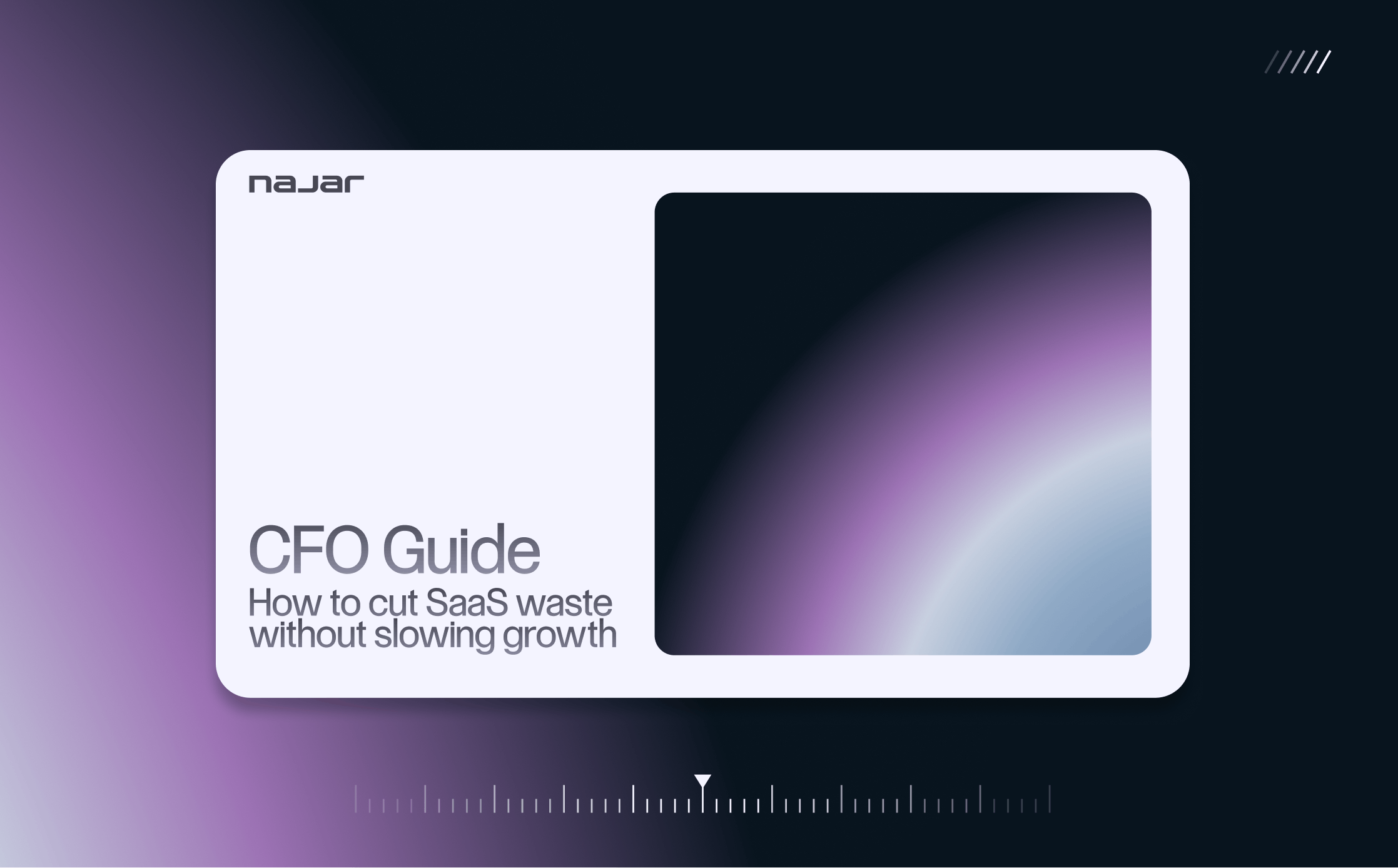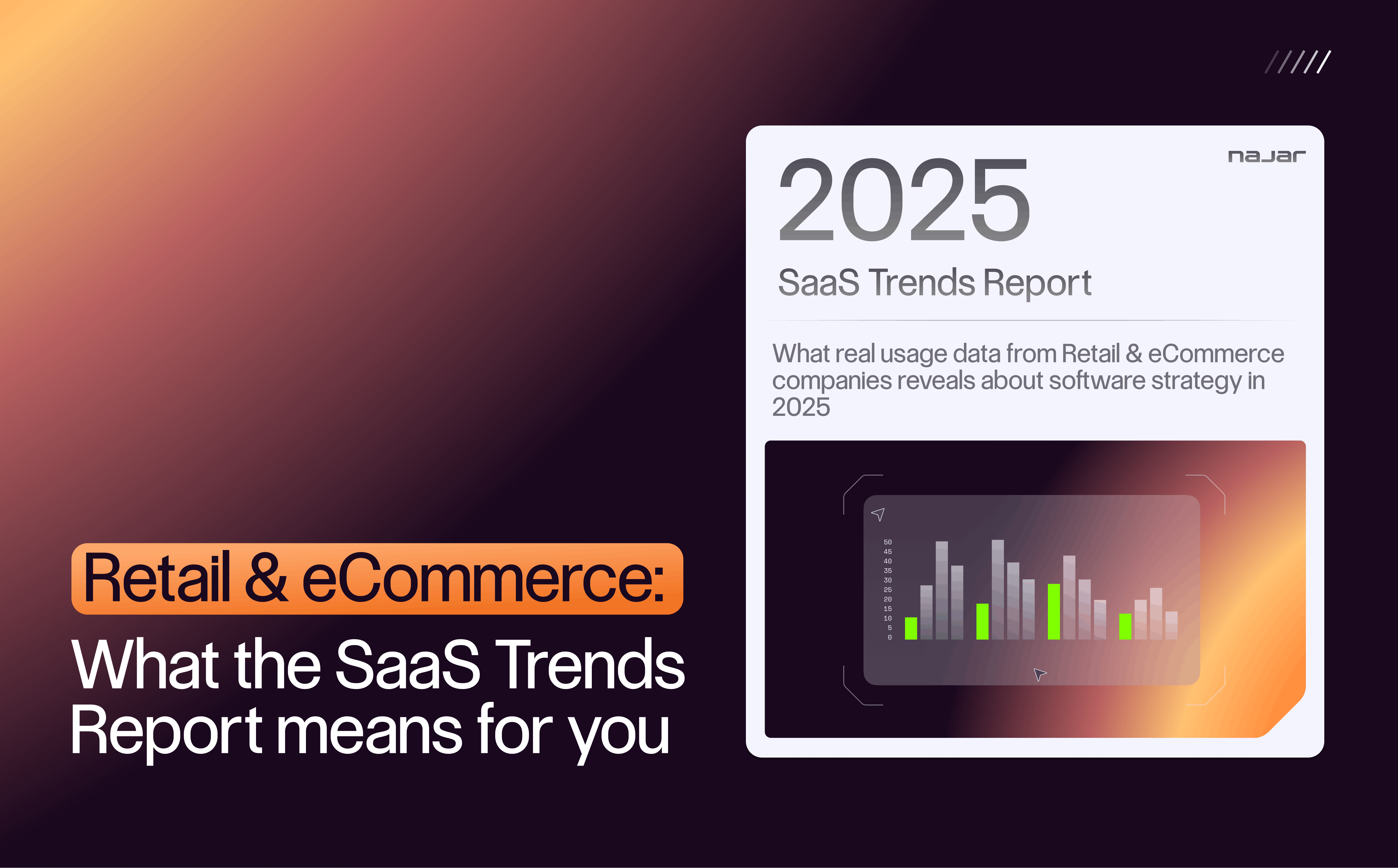Budget season for the fiscal year is upon us, but you (or your CFO) may have very little time to develop and approve everything. Sales, hiring, salaries, investments or even fundraising in preparation... There are many budget items that require a lot of work - and especially vigilance.
But in recent years, there is one that is increasingly feared: the supplier budget.
Companies of all sizes are increasingly collecting SaaS (Software as a Service) tools, and the observation is unanimous:
- The bill at the end of the year is often surprisingly high
- Controlling SaaS expenses is a complex and time-consuming task
Najar clients note that SaaS now accounts for nearly one out of every two vendors, and according to recent studies, a company with 500 employees spends more than €2 million on SaaS tools. Even more astonishing is the fact that 30% of the software is not being used. This figure will multiply in the coming years, so it becomes essential to implement a real methodology dedicated to the SaaS budget.
You will see in this article that if the explosion of SaaS has made the budgeting mission more complex, the exercise must not be overdone... at the risk of seeing expenses overflow as much as usage.
Expert in SaaS management, Najar gives you here the best practices to elaborate and follow your SaaS budget without any headache:
- Recover and consolidate information about your SaaS tools
- Challenge the needs of your teams without hindering your growth
- Build a dedicated culture to better control usage and expenses
- Delegate the management and permanent control of your SaaS tools
How can you effectively build your annual SaaS budgets?
Before the advent (and victory) of SaaS, it was relatively easy to track a software purchase request and allocate the necessary budget to a cost center. The SaaS tools model has created new purchasing options that have made perpetual software licenses obsolete. Each business can now acquire a solution very quickly without going through either the IT department because they do not require installation, or the Finance department: a credit card is all that is needed to pay for the subscription of one or more turnkey solutions.
The underlying problem - when it is not mastered - is that all the information concerning these tools (usage, contracts, billing) is decentralized at all levels of the company. Each department manages its tools autonomously and the risks of overspending (not to mention the security risks) are very high.
We talk about Shadow IT to describe all the expenses and uses that go under the radar of software purchasing processes.
The challenge when building budgets today is to make it a serious business, to allocate the necessary resources for the company's growth by reflecting the needs of the operational teams; while controlling the expenses to determine objectives and stick to them. In other words, there is a balance to be struck between setting conservative, fixed goals and adapting to changes in the business and the market.
Challenge accepted?
The following methodology could help you build your software budget for the upcoming fiscal year:
- Identify costs (who, what, how) and model them
- Integrate changes and evolutions without repeating historical trends
- Identify forecasted needs and make simulations
- And always... analyze variances from actuals
Identify costs to reconstruct the exact expense
This will inevitably take some time (unless you use a SaaS Management tool like Najar), but it is essential.
Here's a checklist to help you do an effective inventory.
Who:
- Start with the supplier ledger data to identify all the paid SaaS that are used in the company.
- Look at the data related to expense reports. Many SaaS licenses are paid for with a business credit card and charged to expenses.
- Survey each department to see if teams are using software that you haven't counted. It can happen that you pay for the same subscription twice without the teams knowing!
What:
- Make sure you have contracts for every SaaS tool you pay for or have paid for (there may be subscriptions still running despite an employee leaving and not cancelling).
- Remember to look closely at any special conditions of use or billing: the increase of the rate after a certain time, or according to a certain number of users for example.
- Distinguish between the different types of payment. Do you pay per user? By user group? By user type? By usage? Monthly, quarterly or annually? This will allow you to anticipate outgoing transactions and build a more accurate budget.
- Identify the currency in which you pay for each subscription. Some countries are not subject to VAT and you may need to factor the cost of conversion into the final amount you pay.
How:
- Assess which departments use SaaS tools the most, as well as their usage patterns (testing, frequent tool changes, etc.) to get an idea of unexpected costs that may arise (termination fees, subscriptions that run without the tool being used, etc.).
Analyze history yes, systematically repeat it no
- Look at the evolution quarter by quarter over two years of history, then gauge the share of increase by adding a share of unexpected expenses for your forecast.
- Consult with each manager to identify which tools are really useful (even essential) and which are less so. Most importantly, do you know what the new needs are? This will help you optimize your investments.
- Consult IT teams to identify under-used applications.
Planning ahead is as much about anticipating as it is about looking ahead
- Determine a cost per user and per department, then analyze the evolution year after year.
- Identify how many employees your company plans to hire, and in general, how the organization will evolve (what promotions are planned, what are the biggest hiring positions, etc.).
- Anticipate a percentage of unexpected costs compared to your observations from previous years. Simply calculate the gap between your budget and actual expenses for the current year and correlate it with your headcount growth. You should reduce this gap by the number of employees in case you decide to recruit more in the next year.
- Set up a rolling forecast for the coming year.
Reduce and control SaaS expenses as usage increases
Challenge needs, contracts and prioritize investments
Once you have an exhaustive vision of the SaaS tools used (or not) in your company, you need to identify potential savings.
First, at the level of the needs that can be challenged:
- Are there not certain redundancies with other tools such as corporate software? This can call into question the credibility of a SaaS.
- Can the tool replace the human or vice versa?
Then, take a (serious) look at (re)negotiating your SaaS contracts!
Beyond reviewing the contractual clauses, calling on a purchasing specialist if you can will allow you to significantly reduce your expenses while making arbitrations from a functional point of view.
The stakes are strategic because SaaS publishers now have strong negotiating power. The law of supply and demand...
If you don't have a purchasing department, you can read this article which details the levers to negotiate a SaaS contract. You should also know that Najar provides its clients with a dedicated buyer expert in SaaS management to renegotiate existing contracts and intervene on new purchases.
Procurement experts can also help you set up a policy dedicated to the purchase of SaaS solutions by defining who can purchase software, when, for whom.... and by ensuring the follow-up of the procedure!
Finally, they can also help you negotiate the transition from capital expenditure (Capex) to operating costs (Opex) - or vice versa - to increase finance budgets.
Manage day-to-day operations to track and control expenses year-round
Controlling the use and especially the costs of SaaS tools has become a real challenge for companies. If you can make your teams aware of this by setting up a purchasing procedure dedicated to these tools and getting the word out to managers, you should already have a clearer picture.
But in order not to restrict either the operational needs of the teams or the growth of your company, you can still give autonomy to SaaS users while controlling their costs and expenses.
How can you do this? By using an application that allows you to manage a fleet of pre-paid, dedicated subscription cards - capped monthly or annually. But also to track expenses in real time and requests, or to remind employees to add their invoices... To improve the daily tracking of "subscription" expenses and the famous accounting reconciliation.
Choose a SaaS Management solution to save time and money
A SaaS Management service can save you time, both in building your annual software budget and in controlling day-to-day spending, anticipating and forecasting.
By using a solution such as Najar, you ensure that you have a real-time and always up-to-date view of
- all used and unused SaaS ;
- all your transactions;
- subscriptions: end/renewal, etc.
But it is also the choice to save a considerable amount of time by entrusting your entire purchasing process, from the identification of your needs to the payment of the SaaS tool.



